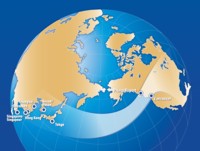Securing Canada's Energy Future
 Canada’s biggest challenge as an energy exporting country is security of demand, and Asia offers the greatest opportunity to respond to this challenge, according to a taskforce report released recently by the Asia Pacific Foundation of Canada (APFC) and the Canada West Foundation.
Canada’s biggest challenge as an energy exporting country is security of demand, and Asia offers the greatest opportunity to respond to this challenge, according to a taskforce report released recently by the Asia Pacific Foundation of Canada (APFC) and the Canada West Foundation.The report, entitled ‘Securing Canada’s Energy Future,’ outlines the case for making a broad-based Canada-Asia energy relationship a national priority. It is a particularly timely analysis given the increased focus on energy exports to Asia being placed by federal and provincial governments in Canada.
The report calls for leadership to develop a strategic framework to enhance energy relations with Asia, which is a primary locus of global economic growth and source of growing energy demand in the foreseeable future.
“At a time when the debate on energy exports is as noisy and confusing as ever, I believe this report is a model of balance, clarity, and purpose,” said APFC President and CEO Yuen Pau Woo.
“It makes no bones about the national importance of energy exports - fossil fuels as well as “green” energy and technology/expertise. But the report also makes clear that environmental and First Nations concerns cannot be treated as an afterthought in project planning and development.”
Several major infrastructure developments are planned as part of a major energy corridor to move Western Canadian energy resources to tidewater for export to Asian markets. The Task Force report calls for such investments, but cautions on the need to treat First Nations issues fairly.
Established in the fall of 2011, the Canada-Asia Energy Futures Taskforce is co-chaired by The Hon. Kevin Lynch, Vice-Chair of BMO Financial Group, and Ms. Kathy Sendall, Director of CGG Veritas.
Mr. Lynch stated that, “We need to think critically, strategically and wisely about Canada’s energy future with Asia. We have an immense opportunity to turn Canada’s energy trade with Asia into a benefit for all regions of Canada, but to do so requires leadership and collaborative innovation on many levels.”
The taskforce, composed of individuals with backgrounds in public policy, business, aboriginal affairs, academia, economics, and sustainable development, offers preliminary recommendations for the creation of a strategic framework on Canada-Asia energy relations.
Key recommendations include:
Think ‘big’ on diversification.
1.Country diversification: China is a priority market, but not the only market. Japan, South Korea, and India are all opportunities for market diversification that can strengthen Canada’s security of demand.
2.Product diversification: Energy clusters can serve as platforms for the expansion and diversification of energy trade with Asia, and can do so in a way that incorporates not only oil and gas, but also renewable energy and green technologies.
3.Industry diversification: Asia’s rising middle classes, as well as the need for major investments in infrastructure, provide opportunities for Canada beyond the energy sector. Canada needs to bolster support to its small and medium-sized enterprises and to pursue public-private trade development partnerships to help firms from various industrial sectors trade successfully in Asia.
4.Diversification through innovation: Universities, governments and industry should collaborate to establish energy innovation institutes to expand the range andquality of energy research and technology.
Promote leadership on all levels.
The federal and provincial governments, the private sector, First Nations governments, communities and environmental groups each have an important role to play in establishing a framework that benefits all parties. The creation of a Canada Council on Asia could bring together Canadian and Asian leaders to provide wise counsel on Canada’s diversification objectives in Asia.
Commit to infrastructure development.
A commitment to invest in hard and soft infrastructure to export energy is a pre-requisite for closer economic ties with Asia. Developing a public energy transportation corridor constituted by government, regulated as a kind of public utility, and operated by the private sector merits further study. This corridor could consist of a combination of pipelines and rail transportation for oil and gas to the west coast.
“We still have a lot to explore in the nascent Canada-Asia energy relationship,” said Ms. Sendall. “We all agree that we can no longer be complacent in how we deal with Asia on the energy file. The window of opportunity will not be open forever, and now is the time to play our strongest card to strengthen our overall relations with the region.”
The Canada-Asia Energy Futures Taskforce was created as part of APF Canada’s National Conversation on Asia (NCA). This project aims to get Canadians thinking and talking about what Asia means to Canada.
You can return to the main Market News page, or press the Back button on your browser.

